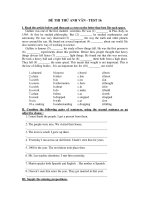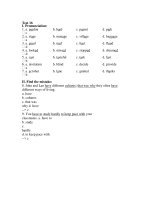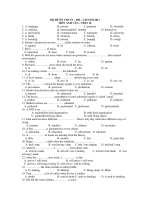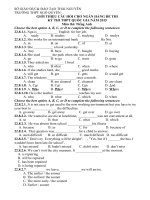Đề thi tiếng anh đề TEST 16
Bạn đang xem bản rút gọn của tài liệu. Xem và tải ngay bản đầy đủ của tài liệu tại đây (84.25 KB, 9 trang )
KỲ THI THPT QUỐC GIA
ĐỀ THỰC HÀNH SỐ 16
Thi thử Kỳ thi THPT Quốc gia Tháng 5/2015:
I.
PHẦN TRẮC NGHIỆM
Read the following passage and mark the letter A, B, C or D on your answer sheet to indicate the correct
answer to each of the questions .
These stories of killer bees in the news in recent years have attracted a lot of attention as the bees have made
their way from South America. Killer bees are reputed to be extremely aggressive in nature, although experts
that their aggression may have been somewhat inflated.
The killer bee is a combination of the very mild European strain of honeybee and the considerably more
aggressive African bee, which was created when the African strain was imported into Brazil in 1955. The
African bees were brought into Brazil because their aggression was considered an advantage: they were far
more productive than their European counterparts in that they spent a higher percentage of their time working
and continued working longer in inclement weather than did the European bees.
These killer bees have been known to attack humans and animals, and some fatalities have occurred. Experts
point out, however, that the mixed breed known as the killer bee is actually not at all as aggressive as the pure
African bee. They also point out that the attacks have a chemical cause. A killer bee stings only when it has been
disturbed; it is not aggressive by nature. However, after a disturbed bee stings and flies away; it leaves its
stinger embedded in the victim. In the vicera attached to the embedded stinger is the chemical isoamyl acetate,
which has an odor that attracts other bees. As other bees approach the victim of the original sting, the victim
tends to panic, thus disturbing other bees and causing them to sting. The new stings create more of the chemical
isoamyl acetate which attracts more bees and increases the panic level of the victim. Killer bees tend to travel in
large clusters or swarms and thus respond in large numbers to the production of isoamyl acetate.
1.The subject of the paragraph before paragraph 1 was mostly likely _______.
A: stories in the media about killer bees
C: the creation of the killer bee
B: ways of producing honey
D: the chemical nature of killer bees attacks
2. The word "inflated" in paragraph 1 means _______.
A: aired
B: burst
C: exaggerated
D: blown
3.Why were African bees considered beneficial?
A: They didn't work hard in inclement weather.
C: They produced an unusual type of honey.
B: They spent their time traveling.
D: They were productive, even in inclement weather.
4.The word 'their' in paragraph 2 refers to _______.
A: the killer bees'
B: the African bees'
C: the honey bees'
D: the European bees'
5.It is stated in the passage that killer bees _______.
A: are more deadly than African bees
B: are less aggressive than African bees
Prepared by Lê Luận 0994 747 821
C: never attacks animals
D: always attack African bees
Prepared by Lê Luận 0994 747 821
6.The pronoun 'They' in paragraph 3 refers to _______.
A: humans and animals
B: experts
C: fatalities
D: killer bees
7.Which is NOT mentioned in the passage as a contributing factor in an attack by killer bees?
A: Inclement weather
C: The odor of isoamyl acetate
B: Panic by the victims
D: Disturbance of the bees
8. In which paragraph does the author describe the size of the groups in which killer bees move?
A: Paragraph 2 and 3
B: Paragraph 2
C: Paragraph 3
D: Paragraph 1
9. Which of the following is NOT a characteristic of killer bees?
A: attack humans and animals
B: are a combination of European honeybee and African bee
C: are aggressive by nature
D: travel in large clusters
10.The main idea of this passage is that killer bee _______.
A: are not purebred
C: are not as aggressive as their reputation suggests
B: have been moving unexpectedly
D: have been in the news a lot recently
Mark the letter A, B, C or D to indicate the underlined part that needs correction in each of the following
questions.
11.Giant tortoises live to great ages, and specimens have been known to live from 100 and 150 years.
A: to
B: Giant
C: to live
D: and
12.By measuring the color of a star, astronomers can tell how hot is it.
A: measuring
B: how
C: the
D: is it
13.Psychologist use standardized test to help measure abilities, aptitudes, interesting, and personality traits .
A: interesting
B: personality traits
C: standardized
D: measure
14.It is estimated that at least a million meteors have hit the Earth’s land surface, which is only 25 percentage of
the planet.
A: percentage
B: at least
C: million
D: have hit
15.Men and women in the Peace Corps work with people in developing countries to help
them improving their living conditions.
A: developing
B: improving
C: living
D: work
Read the following passage and mark the letter A, B, C or D on your answer sheet to indicate the word or
phrase that best fits each of the numbered blanks.
It can take a long time to become successful in your chosen field, however talented you are. One thing you have
to be aware (16) _______ is that you will face criticism along the way. The world is full of people who would
rather say something negative than positive. If you’ve made up your (17) _______ to achieve a certain goal,
such as writing a novel, don’t let the negative criticism of others (18) _______ you from reaching your target,
and let constructive criticism have a positive (19) _______ on your work. If someone says you are totally short
in talent, ignore them. That’s negative criticism. If, however, someone (20) _______ you to revise your work
and gives you good reasons (21) _______ doing so, you should consider their suggestions carefully. There are
many film stars who were once out of work. There are many famous novelists who made a complete (22)
_______ of their first novel – or who didn’t, but had to (23) _______ approaching hundreds of publishers before
they could get it published. Being successful does (24) _______ on luck, to a certain extent. But things are more
(25) _______ to turn out well if you persevere and stay positive.
16. A: into
Prepared by Lê Luận 0994 747 821
B: of
C: on
D: about
17. A: idea
B: mind
C: thought
D: brain
Prepared by Lê Luận 0994 747 821
18. A: avoid
B: prevent
C: remove
D: cease
19. A: outcome
B: effect
C: result
D: consequence
20. A: explains
B: proposes
C: suggests
D: advises
21. A: with
B: up
C: for
D: of
22.A: garbage
B: mess
C: rubbish
D: trash
23. A: bank on
B: put off
C: keep on
D: drop in
24.A: depend
B: focus
C: come
D: go
25. A: likely
B: unlike
C: like
D: likelihood
Mark the letter A, B, C or D to indicate the correct answer to each of the following questions.
26. The Olympic Games are held every four years in a selected country, and _______ to athletes of all nations.
A: they are opened
B: it is open
C: they are open
D: are opened
27. Samples of rock showed _______ 4,600 million years old.
A: how was the moon
B: when was the moon
C: that the moon was
D: to be the moon
28. Pumpkin seeds, _______ protein and iron, are a popular snack.
A: which provide
B: which
C: provide
D: that
29. The key role of the still life in modern art has been as a focus _______ technical and stylistic experiments.
A: in
B: with
C: to
D: on
30. Temperature, the simplest weather element to measure, is probably _______ used than any other kind of
data.
A: frequently
B: most frequently
C: more frequently
D: as frequently
31. Both diamond _______ graphite are made of the same element, which is carbon.
A: together
B: except
C: both
D: and
32. Many mental disorders are believed to result from a combination of emotional, _______, and biological
factors.
A: society
B: to be social
C: social
D: socially
33. Can I _______ you to water the flowers when I am away?
A: try on
B: look at
C: count on
D: turn in
34. An effective paragraph must _______ be unified and ordered but also complete.
A: in addition
B: not only
C: as well
D: either
35. Rarely _______ designer labels at affordable prices.
A: are you find
C: do you find
B: find you
D: you find
36. When we start work in the morning, I usually _______ at the schedule for the whole day.
A: glance
B: glimpse
C: monitor
D: watch
37. The man was arrested when his _______ passport was spotted at the airport.
A: plastic
B: fake
C: artificial
38. I _______ sight of the robber just before he disappeared around the corner.
A: caught
B: got
C: had
39. In the hotel, at the reception:
Receptionist: “Have you got any identification, sir?”
Guest: “Well, I haven’t got my passport. But I’ve got my driving license, ______?
Prepared by Lê Luận 0994 747 821
D: unreal
D: took
A: do you agree with me
B: sure
C: will that be all right
D: of course
Prepared by Lê Luận 0994 747 821
A:
40.However
_______ more than 2,000 B:
minerals
Despiteare known, nearly allC:rocks
Although
are formed from sevenD:
mineral
Since groups.
41. After a quiz:
Long: “I’m depressed. I didn’t do very well on the first quiz.”
A: Put down. Forget everything about that quiz.
B: Hold on. Other tests are more important.
C: Come on. This quiz is not important.
D: Calm down. I'm sure you you'll do better on the other tests.
Minh: “_______.”
42. Canada does not require that U.S citizens obtain passports to enter the country, and _______.
A: Mexico does neither
C: Mexico doesn't, either
B: either does Mexico
D: neither Mexico does
43. The earthquake was ________ powerful that the town was completely destroyed.
A: enough
B: too
C: so
D: such
44. We had the volume turned down so I couldn‟t make _______ what they were talking about.
A: up
B: off
C: in
D: out
Read the following passage and mark the letter A, B, C or D on your answer sheet to indicate the correct
answer to each of the questions.
How much time do you spend stuck in traffic, breathing in diesel fumes as you commute to work or to college
every day? Traffic congestion in the big cities is one of the key issues facing city planners these days. It has
only continued to get worse, despite the attempts to solve these problems. Expensive solutions such as new
flyovers, bus-only lanes, and park-and-ride options are all under consideration in many big cities.
Cycling is a key way of reducing traffic congestion and has other benefits as well. It saves fuel, is healthier for
the cyclists, and reduces air pollution for all other commuters. It provides a more cost-effective and efficient use
of city space by reducing the need of enormous parking buildings and inner-city motorways. Another point is
that cycling is a cheaper alternative than car ownership with its registration fees, fuel costs, and regular
mechanical expenses.
Take a moment to think about those who risk the dangers of busy city roads on a bicycle. Cyclists are the most
vulnerable people in heavy traffic. They move fast, they are balanced on two wheels, and they have no outer
metal shell to protect them. If they are on their way to work, they may well be carrying work-related documents
in a backpack or pannier, which increases the balance problem. As cyclists are much smaller than vehicles,
drivers frequently do not even notice them and accidents are common. Often, especially in hot weather, cyclists
only wear light clothing, which means the injuries they suffer are likely to be serious, even with helmets.
What needs to happen for cyclists to feel comfortable cycling to work? The first major requirement is changing
our ideas so that cycling becomes a sensible transport choice and cyclists are safe on the roads. Public education
is an essential part of this to ensure that other road users are more considerate to cyclists and learn how to drive
safely when bicycles are sharing the roads. Employers also need to be aware of cyclists’ needs. These usually
range from secure cycle tracks to prevent theft to the provision of showers and lockers so people can change
from cycling to business clothes once they arrive at work. The second major necessity is the development of a
safe, convenient network of cycling pathways that link different parts of the city, but ideally are separate from
the regular road system. These cycle paths should also allow for some separation of cyclists and pedestrians, as
people walking can be badly injured or even killed if a cyclist collides with them. In areas where this is not
possible, city streets should have clearly marked cycle lanes with restrictions to prevent drivers from using
them.
Prepared by Lê Luận 0994 747 821
Some cities, for example, Copenhagen and Amsterdam, have made a particular effort to achieve this. They have
developed areas that are either car-free (only for pedestrians and cyclists) or ‘pedestrian priority’, where
pedestrians and cyclists have the right-of-way and cars are only permitted to move at low speeds. Planners
believe that the presence of cyclists at all hours of the day and evening keeps the city safer. Since 1995, there
has been a city bike system in Copenhagen which allows anyone to borrow a bike from one of 110 bike stands
around the city for a small deposit. Once the bike is returned to the same or another stand, this money is
refunded. There has also been an active policy of establishing bike lanes, adding bike crossings to intersections,
and reducing the number of car parks to discourage cars in the central city. Currently, about 34% of commuters
in Copenhagen cycle to work.
Cycling is clearly a healthy and effective alternative to the private car in our congested cities. The greater the
proportion of cyclists to other vehicles, the safer cycling becomes. As some forward-thinking cities have
demonstrated, there are many ways in which local city governments can actively encourage and subsidise
cycling as a positive option for commuters. The most important of these requires some brave decisions to curb
the dominance of the private car, and the gridlock experienced in all major cities shows that such action has
become essential.
45. The word ‘It’ in paragraph 1 refers to ________.
A: city planner
B: traffic congestion
C: key issue
D: big city
46. The following information can be found in paragraph 2.
A: A description of company facilities for employees who cycle to work
B: The fact that cyclists are often not noticed by drivers
C: Statistics to how that cycle-friendly policies are effective
D: A comparison of the cost of owing a bike and a car
47. Which of the following is the best heading for paragraph 3?
A: Cyclists at risk
48. The word ‘these’ in paragraph 4 refers to ________.
A: city governments’ needs
C: cyclists’ needs
B: employees’ needs
D: employers’ needs
49. Which of the following is NOT a new solution to traffic congestion?
A: expansion of road networks.
B: special lanes for buses.
C: overbridges for vehicles.
D: parking areas for motorists or drivers to change to public transport.
50.________ is described as a cycling-friendly development according to the passage.
A: additional taxes on roads at rush hours
C: additional taxes on petrol and diesel
B: free and covered bike parks
D: bikes that anyone can borrow and return later
51. One of the requirements for cycling to work mentioned in the passage is ___________.
A: policies requiring cyclist to wear bright-coloured clothing
B: laws requiring cyclists to wear helmets
C: laws preventing cyclists from carrying documents in backpacks
D: actions taken by employers to support employees who cycle
52. Which reason is NOT listed as reasons for encouraging cycling?
A: to lessen the need for car parks and roads.
C: to move quickly through heavy traffic.
B: to lessen pollution of city air.
D: to lower the number of cars on the streets.
53. The word „forward-thinking‟ in the last paragraph probably means ________.
A: awkward
B: strange
C: conservative
D: pioneering
54. The writer's main idea is ___________.
A: Some city governments have encouraged cycling.
B: Cycling is the key to a reduction of traffic congestion.
C: In the future, cars will need to be banned from cities.
D: Automobiles are shaping our city planning.
Prepared by Lê Luận 0994 747 821
Mark the letter A, B, C or D to indicate the word that differs from the other three in the position of the
primary stress in each of the following questions.
55. A: influence
B: interview
C: behaviour
D: punishment
56. A: kindergarten
B: curriculum
C: encouragement
D: minority
57. A: preferential
B: identity
C: engineering
D: application
Mark the letter A, B, C, or D on your answer sheet to indicate the word whose underlined part differs from
the other three in pronunciation in each of the following questions.
58. A. husband
B. raise
C. distinct
D. reserve
59. A. ivory
B. crisis
C. determine
D. digest
Mark the letter A, B, C or D to indicate the word(s) CLOSEST in meaning to the underlined word(s) in
each of the following questions.
60. Mrs. Mackenzie waited for the class to become quieter before she continued.
A: bring up
B: pass away
C: bring on
D: settle down
61. The precision of tools in a computer manufacturing company is critical.
A: temperature
B: cleanliness
C: size
D: accuracy
62. Before the explosion in the sale of personal computers, people spent a lot more time using typewriters.
A: Succeeding
B: Due to
C: At the time of
D: Prior to
63. After a long, hard struggle, we gradually succeeded in having people accept the truth of our theory.
A) slowly
B) momentarily
C) suddenly
D) graciously
64. After the drops were placed in the patient's eyes, his pupils became dilated.
A) enlarged
B) smaller
C) irritated
D) sensible
II.
PHẦN TỰ LUẬN
A.
1) It isn’t necessary to finish the work today.
You don’t.................................................................................
2) Sally finally managed to get a job.
Sally finally succeeded...........................................................
3) That’s the last time I go to that restaurant.
I certainly................................................................................
4) “I advised you to take a holiday” The doctor said.
“You’d.....................................................................................
5) If you don’t rest yourself you really will be ill.
Unless......................................................................................
B.
TOPIC: Write a letter to pen-pal to talk about your family.
Prepared by Lê Luận 0994 747 821
![Tài liệu [Luyện thi tiếng Anh] REVISION TEST 1 ppt](https://media.store123doc.com/images/document/13/ce/pe/medium_pex1386933310.jpg)








